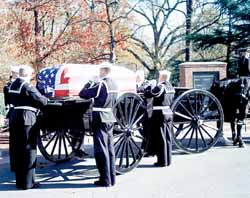13 December 2003:
Mystery of lost WWII pilot solved
U.S. team finds remains of Pembroke woman’s brother in Russia
PEMBROKE – Elizabeth Prenier was 9 years old during World War II when she learned that her brother’s airplane disappeared behind enemy lines.A half-century later, an unexpected letter and a U.S. forensics team helped the Pembroke woman and her family learn what actually happened somewhere over Russia’s Kamchatka Peninsula.
And last month, Lieutenant (j.g.) John W. Hanlon Jr. was buried with honors at Arlington National Cemetery.
Hanlon was 26 and the co-pilot of a Navy PV-1 Ventura bomber that took off with four other planes in a pounding storm from its base at Attu Island in Alaska’s Aleutian chain on March 25, 1944.
There were seven crew members.
Bound for Japanese targets, the bombers took off in darkness. “They were called bats because they flew at night,” Prenier said in a recent interview.
One of the bombers crashed shortly after takeoff, and two later turned back because of the bad weather.
Two continued on their mission: to bomb the northern tip of the Japanese Kuril Island chain to pin down the Japanese air force. The run was called the Empire Express.
Prenier’s son, John Prenier, has become an expert on the mysteries of the Empire Express, and his research has told him that the bombers’ mission that night was part of an Allied effort to make the Japanese believe that the U.S. military might invade from the north.
“They diverted some of the Japanese forces away from [General Douglas] MacArthur’s invasion of the Philippines” far to the south, John Prenier said.
Military officials have speculated that Hanlon’s plane may have been hit by Japanese anti-aircraft artillery. At that time Russia and the United States were allies.
When Hanlon’s plane did not return, his family in Worcester, Mass., was notified – but learned little else.
Elizabeth Prenier said Japanese propagandists who used a woman nicknamed Tokyo Rose in radio broadcasts mentioned Hanlon’s plane over the air and gave the name, rank and serial numbers of the crew members. She said that for a time family members believed their brother might have been a prisoner of war.
John Hanlon had grown up in Worcester, captained the baseball team at College of the Holy Cross, and had been scouted by the Boston Red Sox .
“I can remember going with my godmother up to Holy Cross to see him play,” his sister recalled.
The family heard nothing more about John Hanlon for decades.
Then, in 1962, a Soviet geologist found the wreckage of Hanlon’s plane on the slope of the Mutnovsky volcano on Kamchatka, a peninsula in the Bering Sea.
In those Cold War years, nobody told the Americans, but John Prenier said his research shows that the Soviet KGB – its intelligence service – was informed of the find. “The KGB stripped the plane of all the instruments, all the guns. It exploded some of the bombs,” he said.
Finally, after Russian-American relations thawed, information was shared and one of Hanlon’s squadron members sent a letter to Worcester in hopes of contacting the family.
“Of course my father was long dead,” Elizabeth Prenier said. “Just by chance I have a cousin that now lives across the street [from where her parents lived] and his name was John W. Hanlon.”
Two years ago, a 10-person U.S. archaeological team, including forensics experts, was sent from Hawaii to find the wreckage. Prenier said two of her sisters provided blood samples so that DNA tests could be done. She said there were few remains found.
“There were four crew members that they couldn’t specifically identify, so this burial at Arlington was for the four of them,” Elizabeth Prenier said.
Last month, Prenier and her family, along with the family of the other crew members, buried the remains of their war heroes in Arlington.
She said the Navy handled the burial with dignity.
They were taken to a chapel for a service. Then the casket was placed on a caisson drawn by six horses. The caisson then carried the casket to the gravesite, where taps was played. Then four planes flew overhead.
“They came so low the ground shook,” Prenier said, her voice choked with tears. “As they came over, the fourth plane went off. They call it the missing-man formation. I get goose bumps talking about it.”
Then the flag that had draped the casket was presented to Hanlon’s family.
“I used to hear people talk about closure,” she said. “But I guess I never realized what a good feeling it is. I still get emotional.”
Click Here For More Information
Michael Robert Patterson was born in Arlington and is the son of a former officer of the US Army. So it was no wonder that sooner or later his interests drew him to American history and especially to American military history. Many of his articles can be found on renowned portals like the New York Times, Washingtonpost or Wikipedia.
Reviewed by: Michael Howard

